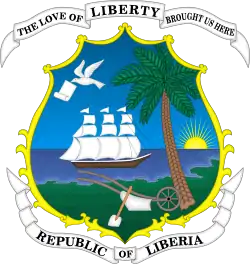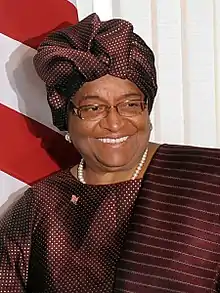1997 Liberian general election
The 1997 Liberian general election was held on 19 July 1997 as part of the 1996 peace agreement ending the First Liberian Civil War. The presidency, as well as all seats in the House of Representatives and the Senate were up for election. Voter turnout was around 89%.[1] Former rebel leader Charles Taylor and his National Patriotic Party (NPP) won the election with 75.3% of the vote, giving it about three-quarters of the legislative seats according to the proportional representation system.[2] Taylor was inaugurated as president on 2 August 1997.
| |||||||||||||||||
| |||||||||||||||||
| |||||||||||||||||
 |
|---|
| This article is part of a series on the politics and government of Liberia |
|
|
Taylor campaigned on, among other slogans, "He killed my ma, he killed my pa, but I will vote for him."[3] The elections were overseen by the United Nations' peacekeeping mission, United Nations Observer Mission in Liberia, along with a contingent from the Economic Community of West African States. Taylor's closest competitor, Ellen Johnson Sirleaf, collected only 10 percent of the vote.
History
In the United States, there was a movement to resettle free-born blacks and freed slaves, who faced legal and other discrimination and persecution, in Africa. Liberia was the main destination for this.[4] The American Colonization Society was founded in 1816 in Washington, DC for this purpose, by a group of prominent politicians and slaveholders.[5] During the mid-19th century, there were continuous clashes between Liberia's colonial government and British merchants from Sierra Leone who claimed that the government had no right to impose taxes on them. To resolve the issue, colonial leaders organized a referendum on independence in 1846, which was in favor. On 26 July 1847, Liberia became independent, but continued to suffer from military coups and other political instability over the following century.[6]
Eligibility
The Legislature of Liberia was modeled based on the Legislature of United States. It was bicameral, with a Senate and the House of Representatives. There are 13 counties in the country and based on the population, each county is defined to have at least two members, while the total number of members to the house including the Speaker being 64. Each member represents an electoral district and elected to a six-year term based on popular vote.[7] There were 26 senators, two each for the 13 counties and they serve a nine-year term (30 senators, 15 counties and nine years from 2011). Senators are also elected based on plurality of votes. The Vice-President is the head of the Senate and he also acts as President in his absence.[7]
To be eligible as a voter, one had to possess 18 years of age and registered on electoral rolls. Persons who are of foreign origin, insane and convicted in crime were not eligible. The eligibility criteria to be candidate of a political party in the House of Representatives was residence in the country for one year before the elections, a tax payer and should be 25 years of age. The eligibility criteria to be candidate of a political party in the Senate was residence in the country for one year continuously before the elections, tax payer and should be 30 years of age.[1]
Background
True Whig Party, founded in 1869, was one of the oldest political parties in the world and the oldest in Africa. The party was in power from 1877. The Party had a majority of Americo-Liberians, who descended from the United States and formed less than one per cent of the total population of Liberia as per the census of 1962. President William Tubman ruled from 1947 until his death in 1971 and William Tolbert continued till 1980. Master Sergeant Samuel Doe lead a group of conspirators and effected the coup on 12 April 1980. Doe's military People Redemption Council (PRC) invoked martial law and took control of all legislative and executive powers. There were a lot of executions, rampant corruption, increasing rate of employment and decreasing health conditions.[8] During 1984, a new draft Constitutional referendum was approved, which allowed a 58-member civilian and military combined Interim National Assembly, headed by President Samuel Doe. The ban on political parties were lifted and the nation went for elections in 1980.[9][10] The election results were announced on 29 October, with NDPL leading both in the Presidential, Assembly and Senate. Doe was sworn-in as the President on 6 January and a civilian cabinet on 15 January.[1] The period after the elections saw increased human rights abuses, corruption, and ethnic tensions, ultimately leading to the start of the First Liberian Civil War in 1989 and Doe's overthrow and murder in 1990.[10]
During the civil war between 1990 and 1997, 2.5 million people died accounting for 10 per cent of pre-war population, one-third were left as refugees and almost most of the population migrated at some point. The Economic Community of West African States (ECOWAS) lead initiatives to bring peace to the nation and an ECOWAS Cease fire monitoring committee was overseeing the agreements. National Patriotic Front of Liberia leader, Charles Taylor was leading the war. There were various treaties signed to bring peace to Liberia, namely, the Cotonou Accord on 25 July 1993, the Akosombo Agreement on 12 August 1994, and its Accra Clarification. Abuja Agreement, one of the last thirteen peace agreement was signed during 19 August 1995 in Nigeria. Taylor agreed to dissolve NPFL and form a civil party later, which went on to be the National Patriotic Party.[11]
Elections
The Election Commission faced challenges in educating the public about the voting, and secrecy of voting. An estimated 70 to 90 percent of the population were illiterate, making it even more difficult to educate them. Also, the True Whig Party's historical dominance had not allowed a pluralistic political culture.[12] The logistical challenges were worsened by the agreement for immediate elections, as most Liberian infrastructure was lost in the civil war. On 14 February 1997, it was announced that elections would be held on 30 May 1997, but a postponement was needed. Sixteen parties participated in the elections: Taylor's NPP and Ellen Johnson-Sirleaf's Unity Party led the race.[1] The elections were finally held on 19 July 1997, with a turnout around 75 percent. The elections were overseen by the United Nations' peacekeeping mission, United Nations Observer Mission in Liberia, along with a contingent from the Economic Community of West African States.[13]
Results
The final results were announced in August, which gave an overwhelming majority to NPP both in the House and Senate. Taylor won the election in a landslide, garnering 75 percent of the vote. Taylor's closest competitor, Ellen Johnson Sirleaf, collected only 10 percent of the vote.[11] Taylor was sworn-in as the President of Liberia on 3 August and his cabinet was announced in the following weeks.[1]
Presidential election
| Candidate | Party | Number of Votes | % of Votes |
|---|---|---|---|
| Charles Taylor | National Patriotic Party (NPP) | 468,443 | 75.33% |
| Ellen Johnson Sirleaf | Unity Party (UP) | 59,557 | 9.58% |
| Alhaji G.V. Kromah | All Liberia Coalition Party (ALCOP) | 25,059 | 4.02% |
| Cletus Wotorson | Alliance of Political Parties (ALLIANCE) | 15,969 | 2.57% |
| Gabriel Baccus Matthews | United People's Party (UPP) | 15,604 | 2.51% |
| Togba-Nah Tipoteh | Liberian People's Party (LPP) | 10,010 | 1.61% |
| George Boley | National Democratic Party of Liberia (NDPL) | 7,843 | 1.26% |
| Harry Moniba | Liberia National Union (LINU) | 6,708 | 1.08% |
| George T. Washington | People's Democratic Party of Liberia (PDPL) | 3,497 | 0.56 |
| Martin Sheriff | National Reformation Party (NRP) | 2,965 | 0.48 |
| Chea Cheapoo | Progressive People's Party (PPP) | 2,142 | 0.34 |
| Henry Fahnbulleh | Reformation Alliance Party (RAP) | 2,067 | 0.33 |
| Fayah Gbollie | Free Democratic Party (FDP) | 2,016 | 0.32 |
| Total | 621,880 | 100 | |
Note: The Alliance of Political Parties was a coalition of the Liberian Action Party (LAP) and Liberia Unification Party (LUP).[11]
Legislative results
Due to the system of proportional representation used in the election, legislative seats were distributed to parties on the basis of percentage of votes won by their respective presidential candidates.[1]
| Party | Votes | % | Seats | |
|---|---|---|---|---|
| Senate[1] | House[14] | |||
| National Patriotic Party (NPP) | 468,443 | 75.33 | 21 | 49 |
| Unity Party (UP) | 59,557 | 9.57 | 3 | 7 |
| All Liberia Coalition Party (ALCOP) | 25,059 | 4.03 | 2 | 3 |
| Alliance of Political Parties (ALLIANCE) | 15,969 | 2.57 | 0 | 2 |
| United People's Party (UPP) | 15,604 | 2.51 | 0 | 2 |
| Liberian People's Party (LPP) | 10,010 | 1.61 | 0 | 1 |
| National Democratic Party of Liberia | 7,843 | 1.3 | 0 | 0 |
| Liberian National Union | 6,703 | 1.1 | 0 | 0 |
| People's Democratic Party of Liberia | 3,497 | 0.6 | 0 | 0 |
| National Reformation Party | 2,965 | 0.5 | 0 | 0 |
| Progressive People's Party | 2,142 | 0.3 | 0 | 0 |
| Reformation Alliance Party | 2,067 | 0.3 | 0 | 0 |
| Free Democratic Party | 2,016 | 0.3 | 0 | 0 |
| Total | 621,880 | 100 | 26 | 64 |
| Source: Nohlen et al. | ||||
Note: The Alliance of Political Parties was a coalition of the Liberian Action Party (LAP) and Liberia Unification Party (LUP).[11]
References
- "Senate Election results of Liberia, 1997". Interparliamentary Union for Democracy for everyone. 1997. Retrieved 22 October 2016.
- Nohlen, D, Krennerich, M & Thibaut, B (1999) Elections in Africa: A data handbook, pp515-518 ISBN 0-19-829645-2
- Left, Sarah (2003-08-04). "War in Liberia". The Guardian. London. Retrieved 2008-01-18.
- "Background on conflict in Liberia". Friends Committee on National Legislation. July 30, 2003. Archived from the original on 14 February 2007. Retrieved 29 October 2016.
- Maggie Montesinos Sale (1997). The Slumbering Volcano: American Slave Ship Revolts and the Production of Rebellious Masculinity, Duke University Press, 1997, p. 264. ISBN 0-8223-1992-6
- Rodriguez, Junius P. (2015). Encyclopedia of Emancipation and Abolition in the Transatlantic World. Routledge. p. 1128. ISBN 9781317471790.
- "About The Republic Of Liberia – Politics". Ministry of Information, Government of Liberia. 2014. Retrieved 23 October 2016.
- Okolo, Julius Emeka (1981). "Liberia: The Military Coup and Its Aftermath". The World Today. Royal Institute of International Affairs. 4 (4): 149–157. JSTOR 40395282.
- Gifford, Paul (1993). Christianity and Politics in Doe's Liberia. Cambridge: Cambridge University Press. p. 22. ISBN 9780521520102.
- Roberts, Brad (1990). The New Democracies: Global Change and U.S. Policy. MIT Press. p. 188. ISBN 9780262680622.
1985 liberia elections.
- Lyons, Terrence (1998). "Peace and Election in Liberia". In Kumar, Krishna (ed.). Postconflict Elections, Democratization, and International Assistance. Lynne Rienner Publishers. p. 177. ISBN 9781555877781.
- Lawrence, Ted (1999). "Illiteracy poses multiple challenges in Liberia". Elections Today. International Foundation for Election Systems (IFES). 8 (2): 10. ISSN 1073-6719. Retrieved 5 November 2016.
- "UNOMIL". Information Technology Section/Department of Public Information. 2001. Retrieved 18 January 2008.
- "Election results of Liberia, 1997". Interparliamentary Union for Democracy for everyone. 1997. Retrieved 22 October 2016.
.png.webp)
